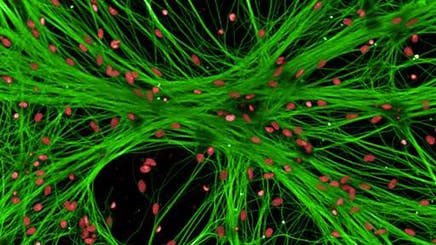
Improving the throughput of a neuroprotection assay using the opera phenix high content screening system

This case study shows how a previously-described neuroprotection assay was easily and directly transferred to the Opera Phenix® high-content screening system, with a 4-fold decrease in acquisition time. In the assay, primary rat neurons are co-cultured on top of rat-derived astrocytes. To induce axon degeneration experimentally, NGF is withdrawn, leading to neuronal cell death, while astrocytes remain healthy. This can be captured by two readouts: the total axon area and the total number of nuclei. Neuroprotective drug candidates lead to an increase in the total axon area while keeping the number of nuclei (astrocytes) constant. Decreasing nuclei counts indicate a cytotoxic effect.
Download the case study to learn how:
- Primary neuron morphology is analyzed in a straightforward approach using Harmony® software
- Careful assay optimization can increase throughput, and minimize the data burden, without compromising assay performance
For research use only. Not for use in diagnostic procedures.
To view the full content please answer a few questions
Download Resource
Improving the throughput of a neuroprotection assay using the opera phenix high content screening system




























